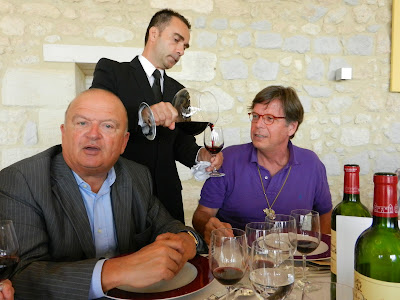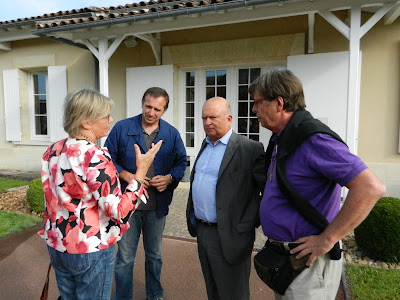Picture: Didier Cuvelier and Christian G.E. Schiller lunching at Château Léoville-Poyferré
I recently had the honor and pleasure to have lunch with Didier Cuvelier at his Château Léoville-Poyferré. The lunch was preceded by a tour of the winery. I have provided a general introduction to Didier Cuvelier at his Château Léoville-Poyferré here: Château Léoville-Poyferré, Chateau Le Crock, Didier Cuvelier in Bordeaux and the Cuvelier Los Andes Wines in Argentina
The Cuvelier Family in the North of France, in Bordeaux and in Argentina
The story begins in 1804 when Henri Cuvelier set out to share his great passion for fine wine with his friends of the grand bourgeoisie residing in the rich and dynamic towns of the North of France, including Lille, Boulogne Sur Mer, Arras, and Valenciennes. To this aim, he created Maison de Négoce de Vins Henri Cuvelier in Haubourdin, a wine merchant company whose success continued to develop throughout the 19th century.
100 years later, at the beginning of the 20th century, Paul Cuvelier and his young brother Albert, decided to purchase top quality estates in the Bordeaux area. They bought Château Le Crock in 1903, then Château Camensac in 1912 and finally the prestigious Château Léoville Poyferré as well as Chateau Moulin Riche in 1920.
Picture: Touring Chateau Leoville Poyferre with Didier Cuvelier
In 1947, Max Cuvelier, under the instructions of his associates, opened a second Wine Merchant company in Bordeaux, moving nearer to the family properties.
Two of Max Cuvelier’s children have taken over the family’s activities in Bordeaux: Didier Cuvelier has been running Chateau Leoville Poyferre, Chateau Moulin-Riche and Chateau Le Crock since 1979 and Olivier Cuvelier has been managing the Wine Merchant company H. Cuvelier and Fils in Bordeaux since 1985.
The Haubourdin wine merchant company was sold in 2002. The name has remained unchanged and it continues to distribute the Cuvelier estates wines.
Pictures: Didier Cuvelier Explaining
In 1998, the Cuvelier family started to branch out to Argentina. Bertrand Cuvelier accompanied Michel Rolland in his great Argentine project, which was to become the« Clos de Los Siete »group. Three years later, Jean-Guy Cuvelier decided to join his cousin Bertrand in the joint aim of building a Winery and producing fine wines worthy of the family tradition. Since then, the Winery has been built and each year the vines of Cuvelier Los Andes have contributed 50% of their production to « Clos de Los Siete », the wine signed by Michel Rolland. The success of this wine is worldwide due to the exceptional value for money it offers.
Château Léoville - Poyferré, Barton and Las-Cases
The Cuvelier family bought Château Léoville-Poyferré – one of the 3 Léoville estates that currently exist - in 1920.
The 3 Léoville chateaux are the result of vast property broken up a long time ago. But up until the French Revolution, Léoville was the largest Médoc wine-growing property.
The story of the 3 Léoville estates go back to 1638. At the time, the estate was called Mont-Moytié, named after its founder, Jean de Moytié. Domaine Mont-Moytié remained in the family for almost 100 years. It is through the marriage of one of the Moytié women that the estate passed into the hands of Blaise Antoine Alexandre de Gascq, who was the seigneur of Léoville and a president of the Bordeaux parliament.
The groundwork for the split was laid in 1769, when Blaise Antoine Alexandre de Gascq died without an obvious heir. As a consequence the Léoville estate was inherited by four family members. One of them was the Marquis de Las-Cases-Beauvoir. One quarter was sold off by the four heirs. A number of years later, in 1826, this part of Léoville estate was purchased by Hugh Barton and became Château Léoville Barton.
The other three quarters remained in the family. This was the state of affairs when the Marquis was succeeded in 1815 by his son, Pierre-Jean and his daughter, Jeanne. Pierre-Jean inherited what is now Château Léoville Las Cases, whilst the portion that came to Jeanne was passed onto her daughter, who married Baron Jean-Marie de Poyferré; this is the part that is today Château Léoville-Poyferré.
Although the estate bears the name of the Poyferré family to this day, it was not in their ownership for a long time. But it was under the ownership of the Poyferré family when the estate was classified as a deuxième cru in 1855 (as were the Barton and Las-Cases estates).
In 1865 Château Léoville-Poyferré was purchased by Baron d'Erlanger and Armand Lalande, bankers and local courtiers. The Lalande family, and later through marriage also the Lawton family, were in charge of Château Léoville-Poyferré until after World War I had passed. The Cuvelier family bought Château Léoville-Poyferré in 1920.
While the vineyards were separated, the buildings remained connected, just as they are today.
Didier Cuvelier and Château Léoville Poyferré
In the beginning, the Cuveliers did not operate their chateaux themselves. Roger Delon, one of the owners of Chateau Leoville Las Cases was the first to manage Chateau Léoville-Poyferré. This changed in 1979 with the accession of Didier Cuvelier, who at 26 became the first member of his family to take charge of Leoville Poyferre, along with Moulin Riche and Le Crock. Didier Cuvelier put Leoville Poyferre on the map of wine lovers all over the world. Didier Cuvelier trained as a chartered accountant before passing the DUAD (a university diploma in wine tasting) in 1976.
When he arrived in 1979, Didier Cuvelier embarked on an extensive program of renovation in the vineyard. Having previously been strong on Merlot, under the direction of Didier Cuvelier the proportion of Cabernet Sauvignon more than doubled, from 30% to its current figure of 65%, the balance being 25% Merlot, 8% Petit Verdot and 2% Cabernet Franc. The vineyard area now totals 80 hectares, compared with 48 hectares in 1979.
Pictures: Tasting after the Tour
In 2010, the vat rooms were completely renovated. 10 large vats were replaced with 20 new, stainless steel double skin vats with a capacity from 60 hectoliters to 165 hectoliters.
The grand vin is Château Léoville-Poyferré (20000 cases). Typically the oak is 75% new each year. Wines produced from the plots once belonging to Château Moulin Riche (17000 cases) are vinified completely in cuve, before transfer into a mix of new and one-year-old barrels. The second wine is Pavillon de Poyferré.
Château Le Crock
The first purchase made by the Cuvelier family was their property in St. Estephe, Chateau Le Crock in 1903.
Today the vineyards of Château Le Crock cover a total of 32.5 hectares and touch two of the most prestigious châteaus of the appellation, Château Cos d’Estournel and Château Montrose.
The vines are 60% Cabernet Sauvignon, 25% Merlot, 10% Cabernet Franc and 5% Petit Verdot.
In the (annulled) 2003 Classification, it was a Cru Bourgeois Superieur. The 2010 Chateau Le Crock qualified for the Cru Bourgeois Label.
Chateau Moulin Riche
Chateau Moulin Richewas bought in 1920 by the Cuvelier family. In 2003, it was incorporated in the Chateau Léoville-Poyferré vineyards.
Lunch
Lunch was served in the large, new reception hall of Chateau Léoville-Poyferré.
Pictures: Lunch with Didier Cuvelier in the large, new reception hall of Chateau Léoville-Poyferré
Fricassee of Monkfish, Cockles and Clams in Saffron Butter
Fillet Mignon
Cheese
Poached Williams Pear in Caramelized Custard
Chateau Léoville-Poyferré 2007
Wine Searcher Average Price: US$ 74
Deep red garnet color in the glass, nose of cedar and tobacco, easy drinking, soft on the palate, a pleasure, given the relatively low price.
Chateau Léoville-Poyferré 2000
Wine Searcher Average Price: US$ 202
Deep red garnet color in the glass, tobacco, cedar, earth, wood, chocolate nose, a big wine, with good tannins and a long finish.
Chateau Léoville-Poyferré 1996
Wine Searcher Average Price: US$ 147
Deep red garnet color in the glass, notes of tobacco combined with gravel and sweet blackcurrant fruit on the nose, full bodied on the palate, good acidity and a good length finish.
Chateau Le Crock 2005
Wine Searcher Average Price: US$ 51
Red garnet color in the glass, notes of red fruits and smoke on the nose, good structure, medium long finish with some notes of roasted coffee.
schiller-wine: Related Postings
Bordeaux Trip September 2012, France
Bordeaux Wines and their Classifications: The Basics
An Afternoon with Owner Michel Tesseron at Château Lafon-Rochet, 4ème Cru Classé en 1855, in Saint-Estèphe, Bordeaux
The Wine Empire of the von Neipperg Family in France, Bulgaria and Germany
Château Léoville-Poyferré, Chateau Le Crock, Didier Cuvelier in Bordeaux and the Cuvelier Los Andes Wines in Argentina
Château Pape Clément in Pessac-Léognan and the World Wide Wine Empire of Bernard Magrez, France
Tasting with Alfred Tesseron the last 10 Vintages of Château Pontet-Canet in Washington DC, USA/France
Tasting the Wines of Chateau Lafon-Rochet, Saint-Estèphe, 4ème Cru Classé en 1855, with Owner Basil Tesseron at the French Embassy in Washington DC, USA/France
Union des Grands Crus de Bordeaux (UGCB) on North America Tour in Washington DC - Schiller’s Favorites
Owner Jean-Bernard Grenié and Wine Journalist Panos Kakaviatos Presented the Wines of Chateau Angélus and Chateau Daugay at Black Salt Restaurant in Washington DC, USA
Subscribe to:
Post Comments (Atom)




















No comments:
Post a Comment